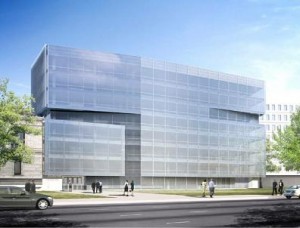An old student of mine who recently opened his own office in Washington, D.C. asked me why I thought the new homegrown architecture of that city was, to put it kindly, uninspired. After serving eight years on the Commission of Fine Arts I’ve seen a lot of projects. Apart from a few buildings by outsiders (Richard Rogers, Bing Thom, David Adjaye) most of the work has been pedestrian, architecturally unambitious, and lacking any real critical thought, that is, intellectually mushy. Without constructive and challenging criticism—which can only come from colleagues, not from critics or clients—practitioners easily get lazy. While there is an enviable amount of construction in DC—federal, municipal, and private—there really isn’t much of an architecture scene, I mean the sort of things that made the Bay Area exciting in the 1950s and 1960s, Philadelphia in the 1970s and 1980s, or LA today. What is needed to make a city a creative hot-bed? The availability of work, of course; a major local figure (a Wurster, a Kahn, a Gehry) helps to attract young architects, train them, and raises the local bar; and a thriving local school of architecture (Berkeley, Penn, SciArc) will reinvigorate office staffs, give part-time employment to fledgling architects, but especially will encourage critical dialogue. But these are conditions, not causes, and the actual chemistry that produces a creative architecture scene is somewhat mysterious. New York and Boston have one, neither San Francisco nor Philadelphia do anymore. Chicago may get one (again), and I would keep my eye on Vancouver, British Columbia, maybe Montreal. Washington, not so much.



Milwaukee has a pretty thriving local scene given the size of the city. UW-Milwaukee provides the office re-invigoration and part-time employment mentioned, and connects to the City itself in a substantial way. It was studios at UWM that argued successfully for tearing down a freeway spur and show the possibilities for riverfront redevelopment. While Milwuakee lacks a prominent local architect, I would argue Santiago Calatrava filled that role from afar during the design and building of the Milwaukee Art Museum expansion. In addition, former Mayor John Norquist (now head of the CNU) helped to elevate the discussion around architecture and urbanism during tenure, hiring UWM faculty member and now Loeb fellow Peter Park to be lead City Planner. Though both have moved on, their influence continues to this day. Finally, the Milwaukee Journal-Sentinel is one of the last dailies to have an architecture critic. Whitney Gould filled the position during Norquist’s tenure, and Mary-Louise Schumacher continues the role part-time while also being the paper’s art critic as well. With several strong offices among UW-Milwaukee faculty and alums, the city has benefited greatly in the last couple decades from and increased awareness of good architecture and urbanism.
Mayors are important, and Milwaukee was lucky to have Norquist. A critic can raise public awareness, no doubt, although I’m not sure he/she can raise the architectural bar. But I’m pretty sure you can’t hire architectural leaders, they must be homegrown. Otherwise San Francisco, which has brought in Piano, Herzog/de Meuron, Thom Mayne and Libeskind would be a hotbed–and it isn’t. Although with the tradition of Maybeck, Morgan, Wurster, Esherick–and Berkeley nearby–it is surely just a matter of time.
The San Francisco Bay Area suffers less from a lack of local figures (see Saitowitz, Hartman(SOM), Fougeron, Ogrydziak/Prillinger, Iwamoto/Scott) than a lack of dialogue and an incredibly conservative building culture. I remember moving here 6.5 years ago and being floored that my two bosses, both solid architects (one who worked for Bruder), didn’t know who John King (SF Chronicle arch/urban critic) was. I think if a city has a critic at the daily, local architects should pay attention.Gould in Milwaukee was a slightly better critic than King, but way better relative to local conditions. Gould did raise the bar in Milwaukee, because she was read not only by architects but by those who employ them, and thus free them or constrain them. I don’t think King has the moral authority to do that in the way Gould did.
Though Berkeley is nearby and the CCA is no chopped liver, I don’t see either engaging the local (arch and general) community nearly as much (relatively) as UWM did in Milwaukee. The local branches of the AIA are no better. Several years ago I attended an exhibition and panel discussion of invited entries to imagine alternatives to the incredibly pedestrian proposal for a Contemporary Art Museum Presidio put forth by Gap founder Donald Fisher. It was held not at UCB, CCA, or the AIA, but in a local office that also has a gallery, Mark Horton Architecture. The room was overflowing, which tells me the interest is there, but it isn’t being fostered by our institutions. Horton is to be highly commended, but could you imagine if this had been put on by SFMoMA? I can’t; it wouldn’t happen.
All of which is to say that I think you mostly need dialogue, both popular and critical. In Milwaukee this was fostered by three local leaders (Norquist, Gould, Park), four local institutions (Milw planning dept, Milw Journal-Sentinel, UWM, MAM), and one outside architect (Calatrava). It matters little that his building actually wasn’t very good (3 of the 4 you mention built way better in SF), but that his appearance focused attention on these issues in the broader community, which upped the ante for local practices. Neither the challenging Mayne nor the accessible Piano did that, and Foster’s pretty terrible Apple headquarters, which should be garnering more interest because of the client, isn’t doing it either.
Until our leadership institutions develop greater popular and critical dialogues regarding these issues, the San Francisco Bay Area will continue it’s trend toward mediocrity, and I’ll continue to pine for the more raucous (if smaller) scene in Milwaukee.